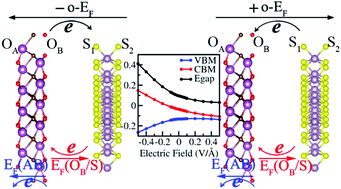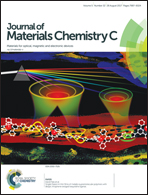Tuning electronic structures of Sc2CO2/MoS2 polar–nonpolar van der Waals heterojunctions: interplay of internal and external electric fields†
Abstract
The role of two-dimensional polar material in electronic modulation has been demonstrated recently in vertical van der Waals (vdW) heterojunctions. Despite the fact that the effect of polarity on the band alignment of polar–nonpolar heterojunctions has been explored, the interplay of the internal electric field and external electric field is not well known in such polar–nonpolar heterojunctions. In this density functional theory (DFT) study, we chose Sc2CO2/MoS2 heterojunctions as a representative polar–nonpolar heterostructure; the dependence of the valence band maximum (VBM), conduction band minimum (CBM), and staggered gap on the external electric field was calculated in detail. The stacking sequence-dependent and asymmetric response of the band edge to the electric field is revealed. Moreover, we find that the VBM (CBM) can be separately modulated by the external electric field in a specific stacking sequence. We finally demonstrate a significant correlation between charge alterations at the interface and band edge shifts. Our results provide strong evidence for the effectiveness of the stacking sequence and interplay of the internal and external electric fields on the electronic properties of polar–nonpolar vdW heterojunctions.



 Please wait while we load your content...
Please wait while we load your content...